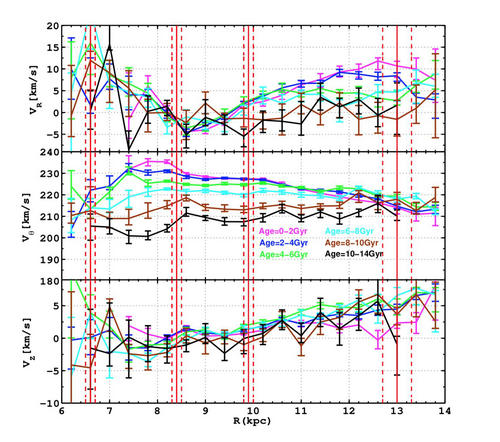An analysis of the three-dimensional asymmetrical kinematics of the Milky Way disk stars in mono-age populations has recently been performed by the LAMOST fellow Dr. Hai-Feng Wang, collaborating with Dr. Martín López-Corredoira of Instituto de Astrofísica de Canarias in Spain, Dr. Jeffrey Carlin of Arizona University in the US, Dr. Yang Huang and Dr. Bing-Qiu Chen of Yunan Univesity, and Prof. Li-Cai Deng of National Astronomical Observatories of Chinese Academy of Sciences (NAOC).
They focus on stars between the Galactocentric distances of R = 6 and 14 kpc, selected from the combined LAMOST DR4 red clump giant stars and Gaia DR2 proper motion catalogue. They confirm the 3D asymmetrical motions of recent works and provide the time tagging of the Galactic outer disk asymmetrical motions in the anticenter direction out to the Galactocentric distance of 14 kpc. Radial Galactocentric motions reach values up to 10 km s-1, depending on the age of the population, and present a north-south asymmetry in the region corresponding to the density and velocity substructures(Wang et al., 2018b, MNRAS, 478, 3367; Wang et al., 2018a, MNRAS, 477, 2858) that were sensitive to the perturbations in the early 6 Gyr. After that time, the disk stars in this asymmetrical structure have become kinematically hotter and thus not sensitive to perturbation. They also find that the structure is a relatively young population and the in-plane asymmetry cannot be easily described by one mechanism accurately. However, with the qualitative and quantitative analysis, they speculate that the in-plane asymmetries might not be mainly caused by a fast rotating bar, intrinsically elliptical outer disk, secular expansion of the disk, or streams, while the spiral arm dynamics, out-of-equilibrium models, minor mergers or others are important contributors.
With quantitative analysis for the vertical bulk motions, they find stars both above and below the plane at R > 9 kpc that exhibit bending mode motions of which the sensitive duration is around 8 Gyr. They propose that the most possible scenario for the vertical motions is consistent with the complex bending and breathing modes produced by the internal perturbation, minor merger or other external perturbations. Warp contributions or other mechanisms might also be a reasonable possible explanation. They suggested that possibly all these mechanisms are coupled together to cause the vertical asymmetry with bending and breathing modes accompanied with mean non zero radial motions for the regions studied in this work under the same dynamical distribution function.
Moreover, it is valuable to emphasize that if assume this vertical motion is caused by the warp which is modeled as a set of circular rings rotating in a plane with an angle to the Galactic plane, they derive a conclusion that the warp is a long lived structure. More works will come out on this topic carried out by the group members.
The paper has been accepted by the Monthly Notices of the Royal Astronomical Society (arXiv:1905.11944).


Figure: The top panel shows the 3D asymmetrical velocity distribution along radius in different population bins colored by age, and the vertical red lines represent the spiral arms. The bottom panel is the likelihood distribution of the warp parameters fitting.

Address: 20A Datun Road, Chaoyang District, Beijing, China code: 100012
Tel: 010-64888708 E-mail: naoc@nao.cas.cn

